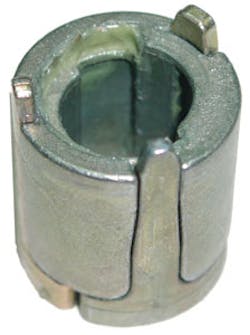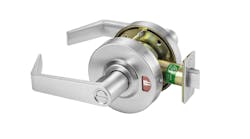A locksmith called recently, asking how he could disassemble a Kawasaki motorcycle ignition lock. He was impressioning a key for the ignition and finally got the key to turn. The problem was that the plug now turned 360 degrees. Regardless of the plug position, the ignition would not turn "on." He decided that something had broken inside the lock during the impressioning process.
The problem was relayed to our vehicle expert, Jeff "Tiny" Trepanier, who had the answer. Jeff is the proud owner of a new Harley Davidson motorcycle and keeps up on everything pertaining to cycles. Jeff told us that this Kawasaki model used a clutch in the ignition lock.
Clutches are not a new invention. German-made vehicles have had clutches on their door locks for a few years. During normal use, a proper key exerts very little force on the lock housing. The lock plug and tailpiece are connected and the lock can be operated normally.
Mercedes sidewinder ignition locks also have clutch-type protection. If someone should try forcing a Mercedes ignition lock, the hardened facecap simply breaks loose and turns, but the plug remains locked. Shear pins actually break off in this case and a new cylinder must be installed.
The fun begins after someone tries to force a clutch-equipped lock. As example, if a screwdriver is inserted into the keyway on most newer VWs, the locked tumblers transfer turning pressure to the housing. As pressure builds up, the housing finally spins and at the same time disconnects the tailpiece from the plug. A thief (or locksmith trying to impression) will accomplish nothing. After the plug has been turned 360 degrees, the tailpiece automatically reconnects and the lock is again usable with the proper key.
Our locksmith working on the Kawasaki had removed the ignition lock and had accidentally broken an inner piece before making the call to Ledger. He had also obtained a used Kawasaki ignition lock, so enough parts were available to make one operating lock which was set to the original key for the cycle. Disassembly was not difficult, but there are two drive pins which had to be drilled out before the facecap could be removed to access the lock plug.
HOW IT WORKS
The inner lock housing has three parts which form 'V'-shaped projections at the front of the housing (Photo 1). The main lock housing has three pockets to accept the projections. This inner housing is held in position by a heavy spring. During regular operation, the plug turns normally within the housing and all parts remain in position.
The lock plug has a small beveled, elevated surface to engage the tailpiece (photo 2). An intermediate driver connects the lock plug to the ignition switch parts. Photo 3 shows the intermediate driver connected to the lock plug during normal operation.
Photo 4 shows the position of the intermediate driver when in a forced open position. The three projections on the inner housing have been moved out of their normal pocket positions. As a result, the inner housing has been moved backward. This movement separates the intermediate driver from the lock plug and disconnects the plug from operating the electric switch.
Kawasaki ignition locks using this clutch system include many models made since 1999. The facecap (photo 5) will contain lettering "KM-8". If the cycle contains a helmet lock, the key code may possibly be stamped on the rear of the lock. Key codes for these models are Z5001-Z6000.
Kawasaki has used the "Z" code series since 1979. Earlier locks used the KA14 / X103 key blank, but this blank is too short for cycles having "KM-8" on the ignition lock. Ilco did make a KA16 / X266 blank, but this blank was also too short. The correct blank is Ilco KW16CP or original Kawasaki blank 27008-1189. Use an Ilco CMC50 code card. Spacing is: 098/ 197/ 295/ 393/ 492/ 591. Depths are: 1.) 258 2.) 238 3.) 218 4.) 199.






